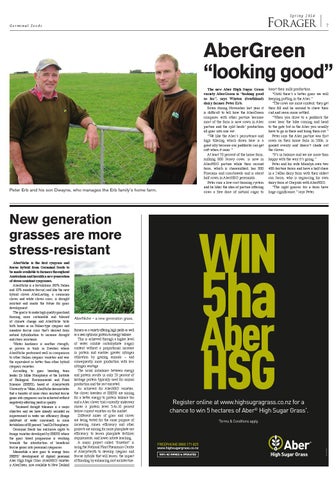S p r i ng 2 014
n
’s e, n B, of d
FORAGER
Germinal Seeds
7
AberGreen “looking good” The new Aber High Sugar Grass variety AberGreen is “looking good so far”, says Winton (Southland) dairy farmer Peter Erb. Sown during November last year it is difficult to tell how the AberGreen compares with other pasture because most of the farm is now sown in Aber pasture and the split herds’ production all goes into one vat. “We like the Aber’s persistence and high tillering which down here is a great ally because our paddocks can get soft when it rains.” At least 70 percent of the home farm, milking 800 Jersey cows, is now in AberHSG pasture while their second farm, which is sharemilked, has 800 Friesians and crossbreeds and is about half sown in AberHSG perennials. Peter runs a low-cost farming system and he likes the idea of pasture offering cows a free dose of natural sugar to
Peter Erb and his son Dwayne, who manages the Erb family’s home farm.
New generation grasses are more stress-resistant AberNiche is the first ryegrass and fescue hybrid from Germinal Seeds to be made available to farmers throughout Australasia and heralds a new generation of stress-resistant ryegrasses. AberNiche is a festulolium (90% Italian and 10% meadow fescue) and like the new hybrid clover AberLasting, a caucasian clover and white clover cross, is drought resistant and marks the future for grass development. The goal is to make high quality grassland farming more sustainable and tolerant of climate change and AberNiche ticks both boxes as an Italian-type ryegrass and meadow fescue cross that’s derived from natural hybridisation to increase drought and stress resistance. Winter hardiness is another strength, as proven in trials in Sweden where AberNiche performed well in comparison to other Italian ryegrass varieties and was the equivalent or better than other hybrid ryegrass varieties. According to grass breeding team leader Dr Mike Humphreys at the Institute of Biological, Environmental and Rural Sciences (IBERS), based at Aberystwyth University in Wales, AberNiche demonstrates that a transfer of more stress resistant fescue genes into ryegrasses can be achieved without negatively affecting yield or quality. “Increased drought tolerance is a major objective and we have already recorded an improvement in water use efficiency (forage yield/unit of water consumed) in some festulolium of 88 percent,” said Dr Humphreys. Germinal Seeds has exclusive rights to forage varieties developed by IBERS where the grass breed programme is working towards the introduction of beneficial fescue genes into perennial ryegrasses. Meanwhile a new grass to emerge from IBERS’ development of diploid perennial Aber High Sugar Grass (AberHSG) varieties is AberGreen, now available to New Zealand
WIN
5ha
Aber
AberNiche – a new generation grass. farmers as a variety offering high yields as well as a near optimum protein-to-energy balance. This is achieved through a higher level of water soluble carbohydrate (sugar) content without a proportional increase in protein and enables greater nitrogen utilisation by grazing animals – and consequently more production with less nitrogen wastage. The usual imbalance between energy and protein results in only 20 percent of herbage protein typically used for animal production and the rest excreted. As achieved for AberHSG varieties, the clover breeders at IBERS are aiming for a better energy to protein balance too and a Aber clover trial currently underway shows a protein level 5-to-10 percent below current varieties on the market. Different mixes of grass and clover are being tested for the same purpose of increasing rumen efficiency and other projects are aiming for more phosphate use efficiency, to lessen phosphate fertiliser requirements, and lower nitrate leaching. A major project called ‘Surefoot’ is using the National Plant Phenomics Centre at Aberystwyth to develop ryegrass and fescue hybrids that will lessen the impact of flooding by enhancing root architecture.
boost their milk production. “Until there’s a better grass we will keeping putting in the Aber.” “The cows are more content, they get their fill and lie around to chew their cud and seem more settled. “When you drive to a paddock the cows hear the bike coming and head to the gate but in the Aber you usually have to go in there and bring them out.” Peter says the Aber pasture was first sown on their home farm in 2006, is grazed evenly and doesn’t shade out the clover. “It’s in balance and we are more than happy with the way it’s going.” Peter and his wife Maralyn own two 400-hectare farms and have a half share in a 240ha dairy farm with their oldest son Jason, who is regrassing his own dairy farm at Orepuki with AberHSG. “The right grasses for a farm have huge significance,” says Peter.
HSG
Register online at www.highsugragrass.co.nz for a chance to win 5 hectares of Aber® High Sugar Grass*. Terms & Conditions apply.
*
FREEPHONE 0800 171 825
www.highsugargrass.co.nz
GSL 0642 ENT
s
